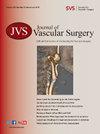Trends, risk factors, and outcomes of selective screening for abdominal aortic aneurysms in at-risk patients
IF 3.9
2区 医学
Q1 PERIPHERAL VASCULAR DISEASE
引用次数: 0
Abstract
Objectives
For men ages 65 to 75 years without a smoking history and for women ages 65 to 75 years with a smoking history, the United States Preventative Service Task Force recommends that primary care providers (PCPs) use their clinical judgement when offering abdominal aortic aneurysm (AAA) screening. This study describes the trends in screening for these cohorts, identifies factors that may influence screening rates, and compares outcomes between screened and unscreened patients.
Methods
The TriNetX population database was queried for subjects with routine PCP visit between ages 65 to 75 from 2007 to 2023 to create cohorts of male smokers, male nonsmokers, and female smokers. Prevalence and 1- and 3-year incidences of AAA screening by ultrasound and computed tomography scans/magnetic resonance imaging (CT/MRI) were calculated. Screened and unscreened patients' demographics, diagnoses, and medications were compared. Rates of AAA diagnosis and repair were compared between unmatched screened and unscreened patients.
Results
Screening for all groups peaked in 2023. Male smokers had the highest screening prevalence (21.2%), followed by male nonsmokers (3.1%) and female smokers (0.90%). The 1-year incidence of screening increased for male smokers, peaking at 8.2% in 2021. The 1-year incidence plateaued at 1.9% for male nonsmokers in 2020 and remained between 0.25% and 0.35% for female smokers for the whole observation period. By 2023, 23.6%, 14.3%, and 24.3% of male smokers, male nonsmokers, and female smokers had been screened via CT/MRI, respectively, with CT/MRI comprising the majority of screening events for all three cohorts. Hyperlipidemia and statin use were associated with screening for all groups (P < .05), whereas a personal history of coronary artery disease was associated with no screening. Screening for male nonsmokers was associated with hypertension, diabetes, and chronic pulmonary obstructive disease (P < .05). Screening in female smokers was associated with family history of coronary artery disease (odds ratio, 1.50; P < .001). For all groups, screening was associated with unruptured AAA diagnosis and endovascular aortic repair (P < .05). Screened female smokers had similar rates of AAA diagnosis as male nonsmokers (4.58% and 4.37%, respectively).
Conclusions
AAA screening in all at-risk populations increases diagnosis and treatment of AAA, but the screening rate is low for all groups, even with increasing CT/MRI use. Patients with strong risk factors for AAA are not undergoing screening. Collaboration with PCPs is necessary to increase screening rates and ensure that patients with the most clinically consequential risk factors are managed appropriately.
高危患者腹主动脉瘤选择性筛查的趋势、风险因素和结果。
目的:对于65-75岁无吸烟史的男性和65-75岁有吸烟史的女性,美国预防服务工作组建议初级保健提供者(PCP)在提供腹主动脉瘤(AAA)筛查时使用他们的临床判断。本研究描述了这些队列的筛查趋势,确定了可能影响筛查率的因素,并比较了筛查和未筛查患者的结果。方法:在TriNetX人口数据库中查询2007-2023年间65-75岁的常规PCP就诊对象,创建男性吸烟者、男性不吸烟者和女性吸烟者的队列。计算超声和CT/MRI筛查AAA的患病率、1年和3年发病率。比较筛查和未筛查患者的人口统计、诊断和用药情况。比较未匹配筛查和未筛查患者的AAA诊断率和修复率。结果:所有组的筛查在2023年达到高峰。男性吸烟者的筛查率最高(21.2%),其次是男性不吸烟者(3.1%)和女性吸烟者(0.90%)。男性吸烟者一年的筛查率增加,在2021年达到8.2%的峰值。2020年,男性非吸烟者的年发病率稳定在1.9%,在整个观察期内,女性吸烟者的年发病率保持在0.25-0.35%之间。到2023年,分别有23.6%、14.3%和24.3%的男性吸烟者、男性非吸烟者和女性吸烟者通过CT/MRI进行筛查,其中CT/MRI占所有三个队列筛查事件的大部分。结论:所有高危人群的AAA筛查增加了AAA的诊断和治疗,但所有人群的筛查率都很低,即使增加了CT/MRI的使用。有强烈AAA危险因素的患者不接受筛查。与pcp合作是必要的,以提高筛查率,并确保具有最重要临床风险因素的患者得到适当管理。
本文章由计算机程序翻译,如有差异,请以英文原文为准。
求助全文
约1分钟内获得全文
求助全文
来源期刊
CiteScore
7.70
自引率
18.60%
发文量
1469
审稿时长
54 days
期刊介绍:
Journal of Vascular Surgery ® aims to be the premier international journal of medical, endovascular and surgical care of vascular diseases. It is dedicated to the science and art of vascular surgery and aims to improve the management of patients with vascular diseases by publishing relevant papers that report important medical advances, test new hypotheses, and address current controversies. To acheive this goal, the Journal will publish original clinical and laboratory studies, and reports and papers that comment on the social, economic, ethical, legal, and political factors, which relate to these aims. As the official publication of The Society for Vascular Surgery, the Journal will publish, after peer review, selected papers presented at the annual meeting of this organization and affiliated vascular societies, as well as original articles from members and non-members.

 求助内容:
求助内容: 应助结果提醒方式:
应助结果提醒方式:


